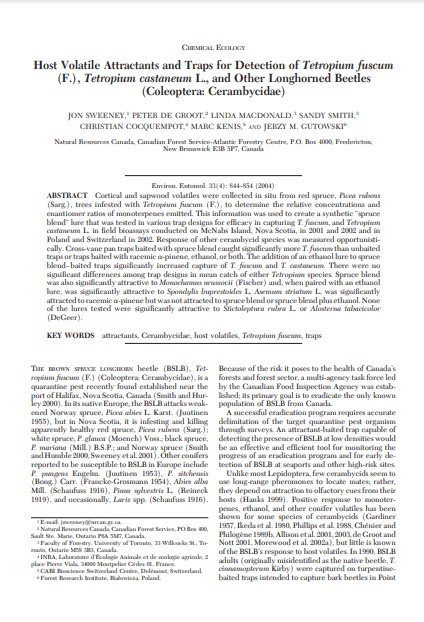Host Volatile Attractants and Traps for Detection oTetropium fascum (F.), Tetropium castaneum L., and Other Longhorned Beetles (Coleoptera: Cerambycidae)
Bosque Modelo:
Fundy
Temática:
Gestión forestal
Tipo de documento:
Artículo científico
Resumen
Cortical and sapwood volatiles were collected in situ from red spruce, Picea rubens (Sarg.), trees infested with Tetropium fuscum (F.), to determine the relative concentrations and enantiomer ratios of monoterpenes emitted. This information was used to create a synthetic “spruce blend” lure that was tested in various trap designs for efficacy in capturing T. fuscum, and Tetropium castaneum L. in field bioassays conducted on McNabs Island, Nova Scotia, in 2001 and 2002 and in Poland and Switzerland in 2002. Response of other cerambycid species was measured opportunistically. Cross-vane pan traps baited with spruce blend caught significantly more T. fuscum than unbaited traps or traps baited with racemic -pinene, ethanol, or both. The addition of an ethanol lure to spruce blend–baited traps significantly increased capture of T. fuscum and T. castaneum. There were no significant differences among trap designs in mean catch of either Tetropium species. Spruce blend was also significantly attractive to Monochamus urussovii (Fischer) and, when paired with an ethanol lure, was significantly attractive to Spondylis buprestoides L. Asemum striatum L. was significantly attracted to racemic -pinene but was not attracted to spruce blend or spruce blend plus ethanol. None of the lures tested were significantly attractive to Stictoleptura rubra L. or Alosterna tabacicolor (DeGeer).
Información Bibliográfica
Autor:
Sweeny, J, P De Groot, L MacDonald, S Smith, et al.
Revista:
Environmental Entomology
Año:
2004
N°:
4
País :
Canadá
Páginas:
844 - 854
Volumen:
33
Idioma:
Ingles
Palabras claves
attractants, Cerambycidae, host volatiles, Tetropium fuscum, traps





